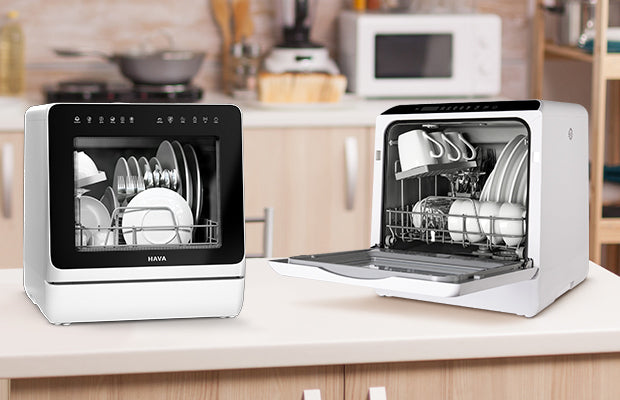Washing dishes with a dishwasher is as easy as loading them into the machine and walking away. This makes it particularly helpful after a big meal. However, this helpful dishwashing machine sometimes malfunctions by leaking water. If not addressed quickly, this leak could damage your floors, walls, cabinets, and the dishwasher.
There are many reasons why a dishwasher could leak from the bottom. In this article, we'd discuss 8 major reasons why a dishwasher is leaking from the bottom and how to fix it. So, read on.
Part 1. 8 Reasons a Dishwasher is Leaking from the Bottom
There are numerous causes of the dishwasher leaking from the bottom when running. However, below are the major reasons dishwashers leak from the bottom.
A Clogged Filter
When water that would normally drain from the washing machine becomes stuck inside, it could be the reason the dishwasher leaks from underneath. The filter at the dishwasher's bottom primarily keeps larger pieces of food, grease, and debris from clogging the drain line. However, the dirt inside the dishwasher can eventually build up to the point where the filter becomes blocked. This happens when the filter is not routinely cleaned.
Fixing the clogged filter is rather simple. You need to clean the dishwasher's bottom of any food, fat, grease, and other particles, then remove the filter and completely wash it.

Faulty Inlet Valve
The intake valve's performance determines how much water enters the dishwasher. You may check the inflow valve's efficiency by opening the dishwasher in the middle of the cycle. The inlet valve is probably broken if the water fills up even with the door open. If the dishwasher's bottom plate is examined more closely, it may show evidence of a valve leak that is currently occurring, such as drips or hard water buildup at the valve.
If you notice that the leak results from a faulty valve, installing a new one according to the manufacturer's instructions would solve this problem. Ensure you firmly reattach all the disconnected dishwasher components after changing the valve.
Leaking Door Panel Seal
A worn-out or faulty door panel seal could also cause the dishwasher to leak from the bottom when not running. This seal, which goes around the door like a rubber gasket, helps stop water from dripping out of the device while it is in use. However, the water within the dishwasher could leak out through tiny gaps or irregularities in the seal if the gasket is split, torn, strained, or otherwise damaged.
Fixing this leaky gasket problem involves peeling away the old seal from the dishwasher door. Then ordering a replacement door panel seal compatible with the dishwasher model you have. Ensure you clean the channel with warm soapy water to remove debris. A new door panel seal might be a bit rigid, so you can make it more pliable by warming it up using low heat on a hairdryer before fixing it on the door.
A Faulty Float Switch
An arrangement of floats and float switches called a float systemis located inside the dishwasher. The right water level within the dishwasher is maintained by this component when it is in use. The float rises with the water level as the dishwasher fills the tub with water to wash the dishes. When the water reaches a preset level, the float switch triggered by the float turns off the water.
A faulty float switch would not turn off the water at the preset level, which means the tub would continue to fill with water until the dishwasher can no longer contain it. When this happens water leaking from the bottom occurs. Resolving this issue means replacing the faulty float switch with a new one.
Broken Water Pump System
A leaking pump seal is another reason if you've detected a leak from the dishwasher's base. During operation, the pump draws water into the dishwasher. But if the seal is worn or damaged, water could leak out around the seal. To identify the source of the leak, examine the pump housing and the dishwasher motor. Swapping out the rubber pump seal is your best bet for fixing this issue of the dishwasher leaking water from the bottom.
Damaged Drain Hose
A drain pipe (fluid conveyance) moves water between locations and could cause water to leak from the bottom of the dishwasher if it is damaged.To check if the leaking dishwasher is due to a damaged drain hose, while the drain line is running,take off the kick-plate under the door, get a torch, and turn the dishwasher on.
Take your time looking over the drain pipe because dishwasher leaks aren't usually obvious right away. If you find any issues, you will need to buy a new drain hose and possibly new fittings to keep the line in place. Disconnect the hose from the dishwasher and set a small container underneath it to catch any leaks.
To completely remove the hose, turn it around and use needle-tip pliers to tighten the clamp and pull it away from the pump. The new drain line should be connected to the dishwasher pump after being connected to the wash basin drain. Run the dishwasher with the kick-plate off to ensure the hose is tightly attached and free of leaks.
Loose Door Latch
If the dishwasher door cannot close all the way, it could cause the dishwasher to leak from the bottom of the door. Since the water drips and collects on the floor, it may appear that the dishwasher has leaked from the bottom. Dishwasher door leaks can be fixed by fitting a new door latch that fits the dishwasher's brand and model.
Corroded Dishwasher Tub
The tub is the large basin that takes up most of a dishwasher. This tub is prone to wear, tear, and damage from long use orpotent chemical detergents. When worn out, itmaycausea leak from the bottom of the dishwasher.
If you discover thata corroded dishwashing tub is producing the leak, it is advisable to contact a skilled dishwasher specialist or plumber to assess the problem.
Part 2. How to Prevent Your Dishwasher from Leaking?
While there is no guarantee that your dishwasher will never leak, some measures could prevent the dishwasher from dripping from the bottom. These measures include;
- Mold buildup and dirt often degrade the door gasket faster, which could result in a leaky dishwasher. One way to ensure this does not happen is by often cleaning the door gasket by hand or with an old toothbrush. Doing this would help prevent mold buildup and increase its longevity while saving costs on replacement gaskets.
- The drain hose is another component of the dishwasher often implicated in leakages. One way to protect your property from water damage is by periodically inspecting the drain hose for wear and tear. This periodic inspection lets you know when the drain hose is due for replacement before the dishwasher leaks. Also, watch your dishwasher to ensure water does not flow back into it during operation.
- Using cleaners specially designed for it, clean your dishwasher once a month. This thorough cleaning would include checking the filter and other components of the dishwasher and ridding them of dirt and debris.
- Sufficient water pressure is important for a dishwasher to operate optimally. Without this water pressure, leakages could occur due to water accumulation. This is why it is best to check often if your dishwasher has the ideal water pressure required for efficient operation.

Part 3. When to Replace Your Dishwasher
Is your dishwasher older than 10 years? Is it giving you a lot of challenges? Or are you tired of fixing it? Then it is probably time to swap it for something more modern like the HAVA countertop dishwasher.
Being one of Amazon's Bestsellers, the HAVA dishwasher is one of a kind. Although compact, this dishwasher has a huge capacity and can fit two place settings, making it perfect for use in a kitchen, RV, or boat. Regardless of the type of dirt, it thoroughly cleans your dishes thanks to its 5 wash cycles and dry mode. The wash cycles include; Normal, speed, soft, fruit, and Baby care/Heavy.
The HAVA countertop dishwasher features upper and lower spray arms. These arms facilitate 360-degree cleaning, ensuring that your dishes are immaculate when finished. Its dual-layer glass door and LED interior light give you an optimal view of the dishwasher's interior, while its LCD control panel makes it quite easy to use.

The HAVA countertop dishwasher stands out for its two water supply options and 75% lower water usage rate. With two water supply options, we imply that you can use the 5L built-in tank or connect directly to the water tap with this dishwasher improving usage flexibility.
Conclusion
Dishwasher leaking from the bottom is common problem owners often encounter when using this machine. Here we discussed the common causes of this challenge and how to fix it. However, if you discover you need to change your dishwasher, consider the HAVA countertop dishwasher.
The HAVA dishwasher is water and energy efficient and has 5 wash modes, a dry mode, and 360 washing. It also has a water storage unit, ensuring you do not need a connection to a water tap to wash your dishes! So why wait? Get your HAVA countertop dishwasher today.















